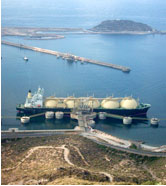Australia is going through an excellent expansion period as a producer and exporter of gas in the LNG market. Currently, there are five LNG plants under construction and ten in different preliminary phases. The production capacity could become 110.8 million Mt in 2012 from the 19.9 million already in existence as of June 2011.
Japan has substituted part of its nuclear energy for gas. This means a need from gas of between 10 and 12 million Mt a year.
China will construct 24,000 Km of pipeline and four LNG terminals within the next five years. Currently it has four LNG terminals in operation (Guangdong, Fujian, Shanghai and Dalian) with a capacity of about 15.3 million Mt.
In December, the construction of the first installation of a floating natural gas installation in the north part of the city of Tianjin was revealed, with a capacity of 2.2 million Mt/year. The second phase would put the construction of a terminal in operation, with a capacity for 6 million Mt and two tanks of 160,000 m3 each. This would be operating in 2015.
China a Uzbekistan signed an investment agreement in the spring of 2011 to spread the supply of natural gas toward China. Remember that from 2009, China has been supplied by a pipeline that starts in Turkmenistan. This new agreement means that from the territory of Uzbekistan, additional amounts of gas will be supplied that will use the already existing pipeline. This pipeline is 2,000 Km long, reaching the northeast of China.
On June 30, the Central Asia-China pipeline was put into operation, 8,700 Km long. It is a project that transports 30 bcm/year through a main line and eight sub-lines from east to west China. Most gas comes from Turkmenistan, which has already been noted.
The Vietnam gas development plan for 2016-2025, which was recently approved by the government, is contemplating the construction of three LNG terminals (in the North, South and Center, the first in the South). The first phase of the South terminal would be finished in 2015, with a capacity of 3 to 5 bcm/year. The goal is also to increase the production, until reaching 15-19 bcm in 2025.

-
 Shell
Shell

